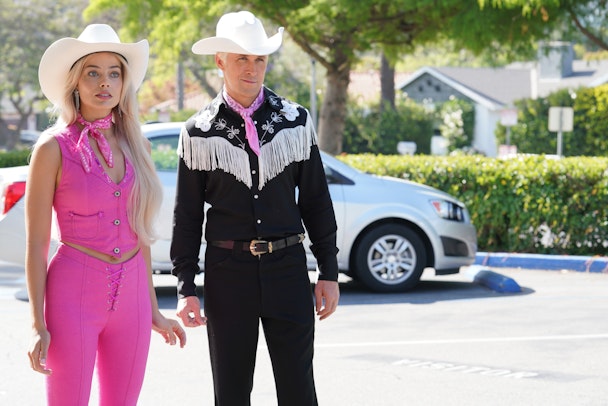Barbie v Oppenheimer or: how I learned to stop worrying and love the blonde bombshell
Today, the biggest double feature in modern movies descends on box offices: Barbie versus Oppenheimer. Anna Vincent of 33Seconds looks at the phenomenon that buoyed both releases and might just save cinema.

The Barbenheimer effect: good for movies, and good for marketing? / Credit: Warner Bros
Left versus right. Leave versus remain. Logan versus Kendall. One look at the trending conversations on Twitter lately, and it’s clear we’re living through polarizing times. In the boxing ring of social media, where strong opinion is king, and tribalism beats nuance every time, we can tie on our colors, jump into the fray, and duke it out for whichever side we’re supporting.
This week, the colors in question are pink and black, with today finally seeing the big-screen release of Greta Gerwig’s Barbie and Christopher Nolan’s Oppenheimer. The films are going head-to-head in perhaps the most gloriously mismatched box-office dust-up ever seen.
In the pink corner: Gerwig’s celebration of the world’s most iconic doll sees Margot Robbie’s Barbie and Ryan Gosling’s Ken swap their dream home for a taste of the real world. Three-time Oscar nominee Gerwig’s low-fi ‘mumblecore’ roots are a far cry from the gleaming Hollywood blockbuster she’s about to become best known for, but her light touch and indie chops are likely to serve her well and ensure that (despite its subject matter) the film will be anything but plastic and superficial.
In the black corner: five-time Oscar nominee Christopher Nolan’s three-hour apocalyptic epic starring Cillian Murphy as physicist Robert J. Oppenheimer, father of the atomic bomb. Shot with IMAX cameras and boasting a heavyweight supporting cast, the film is set to be a visual treat and a movie buff’s dream. Certainly a darker and gloomier proposition than its perky, pink-clad sparring partner.
The Barbenheimer effect
Whichever one you fancy in this fight, you’ll probably be aware of the steadily growing buzz around both films, which has erupted into a thundering roar over recent weeks following a year-long campaign of cleverly executed teasers and trailers on both sides.
But something else has happened too: something a little unexpected and, from a marketing perspective, impossible to ignore.
Gerwig’s film, with its obvious merchandising tie-ins and broader appeal, has long been on track to have the more impressive opening weekend financially. But when the dust settles, both films will have benefitted from something far more important, cementing them in the zeitgeist in a way neither could have achieved alone. Some are calling this the ‘Barbenheimer’ effect.
Greta Gerwig and Margot Robbie seated for Oppenheimer pic.twitter.com/1YxSJk38dB
— Film Updates (@FilmUpdates) June 30, 2023
Counterprogramming (the tactic of releasing films catering to disparate audiences on the same day) is nothing new. Here, though, it has been harnessed to near-genius effect. Rather than shutting down communications which might, on the face of it, have seemed ‘off-message’, both sides have leaned into the outlandishness of the double-billing and soaked up the mutual benefits, even allowing their respective stars to break the fourth wall during promotional activities.
Greta Gerwig and Margot Robbie blew up Twitter a few weeks ago when they posted pictures of themselves buying tickets to see the Nolan film, and Cillian Murphy recently cited the double-billing as "great for the industry and for audiences.”
"I'll be going to see Barbie 100%. I can't wait to see it!" -Cillian Murphy pic.twitter.com/0pXqikGoJQ
Social media audiences, too, have been invited to celebrate not only what makes the films different (which is, on the surface, everything), but also to revel in what unites them. Meme-makers and commentators have found fertile new ground in this most unlikely of crossovers, going so far as to envisage a universe in which the two stories take place on the same timeline (although stopping short of ‘shipping’ Barbie and ‘Bobby’… so far).
A sign of the times?
Of late, it hasn’t been a case of which film you will see, but which one you will see first. Fans have been bickering on Twitter over the optimum running order (Oppenheimer to start, with a much-needed Barbie chaser, obvs), and cinemas have scheduled screenings to allow fans to indulge in an old-school double-bill (even laying on signature cocktails in the bougier venues).
In the wake of the pandemic and in the age of streaming, it has felt like a long time since cinema has been able to catch hold of the public imagination in this way. Perhaps it’s rallying and ready to go another round. It’s a testament to the continuing and ever-evolving power of social media that this can still happen; a reminder that it can be a positive force when approached with a little bit of imagination and a healthy dose of humor.
Untethering the cultural conversation like this allows it to roam away from the overly trodden path of ‘us versus them’ or 'winners and losers' towards something more harmonious, collaborative, and interesting.
In a world where plastic dolls and atomic bombs exist side-by-side, it’s sometimes hard to be truly optimistic, but if this is a sign of the future of marketing and online discourse, then maybe there’s hope after all.
Content by The Drum Network member:

33Seconds
33Seconds is an independent, award-winning communications agency, specialising in climate, technology and lifestyle.
As well as offering services across strategy,...

